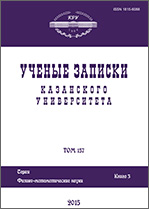|
|
Kazanskii Gosudarstvennyi Universitet. Uchenye Zapiski. Seriya Fiziko-Matematichaskie Nauki, 2006, Volume 148, Book 4, Pages 94–143
(Mi uzku577)
|
 |
|
|
This article is cited in 3 scientific papers (total in 3 papers)
Exactly equilibrated fields, can they be efficiently used for a posteriori error estimation?
I. E. Anufrieva, V. G. Korneeva, V. S. Kostylevb
a Saint-Petersburg State Polytechnical University
b All-Russian Scientific Research Institute of Hydraulic Engineering
Abstract:
The answer given in the paper to the question in the title: yes, they can. We advocate the approach to the a posteriori error estimation, which can be called “classical”, and for the theory elasticity problems stems from the Lagrange and Castigliano variational principles. In it, the energy of the error of an approximate solution, satisfying geometrical restrictions, is estimated by the energy of the difference of the stress tensor corresponding to the approximate solution and any stress tensor, satisfying the equations of equilibrium. Notwithstanding a popular point of view that the construction of equilibrated stress fields requires considerable computational effort, we show that it can be practically always done for the number of arithmetic operations, which is asymptotically optimal. We derive also new general a posteriori estimates, in which equilibrated fields are replaced by arbitrary fields of fluxes/stresses. Numerical experiments show that our a posteriori error estimators provide very good coefficients of effectiveness, which in many cases can be convergent to the unity. At the same time they have linear complexity and are robust.
Received: 13.12.2006
Citation:
I. E. Anufriev, V. G. Korneev, V. S. Kostylev, “Exactly equilibrated fields, can they be efficiently used for a posteriori error estimation?”, Kazan. Gos. Univ. Uchen. Zap. Ser. Fiz.-Mat. Nauki, 148, no. 4, Kazan University, Kazan, 2006, 94–143
Linking options:
https://www.mathnet.ru/eng/uzku577 https://www.mathnet.ru/eng/uzku/v148/i4/p94
|

| Statistics & downloads: |
| Abstract page: | 236 | | Full-text PDF : | 72 | | References: | 61 |
|




 Contact us:
Contact us: Terms of Use
Terms of Use
 Registration to the website
Registration to the website Logotypes
Logotypes







 Citation in format
Citation in format 
